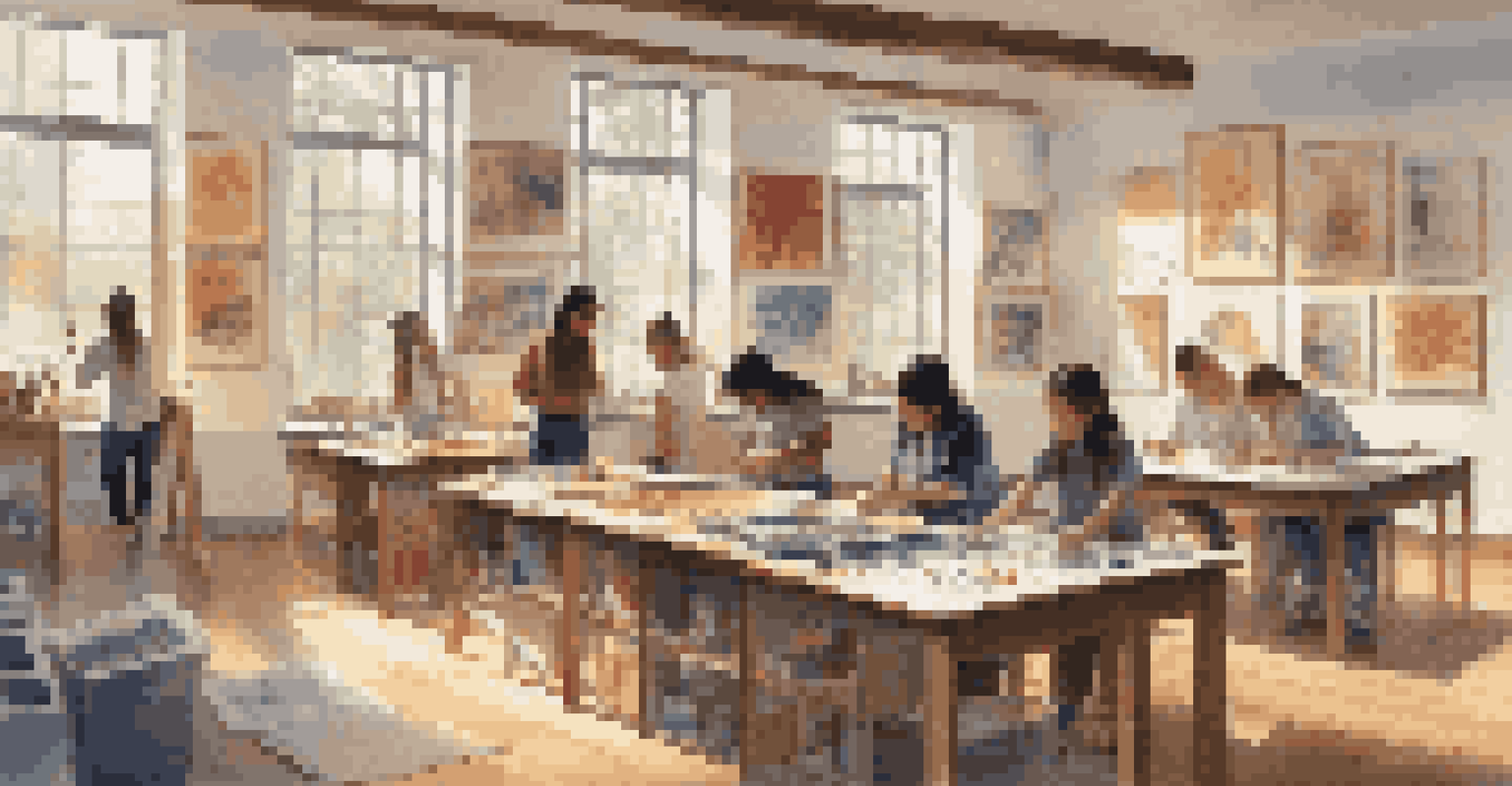The Role of Art Education in Fostering Cultural Understanding

Understanding Art Education and Its Importance
Art education encompasses the teaching of various forms of artistic expression, including visual arts, music, dance, and theater. It plays a crucial role in developing creativity and critical thinking among students. By engaging with different art forms, students learn to appreciate diverse perspectives and cultural narratives.
Art is the most beautiful of all lies.
Moreover, art education is not just about technique; it involves exploring the emotions and stories behind the art. This exploration fosters an environment where students can connect with their own experiences and those of others. As they learn about different cultures through their artistic expressions, they gain insights that enrich their understanding of the world.
Ultimately, art education serves as a bridge, linking individuals from diverse backgrounds and encouraging dialogue. It reinforces the idea that everyone has a unique story to tell, which is essential in a multicultural society.
Art as a Medium for Cultural Exchange
Art has the unique ability to transcend language barriers and communicate universal emotions. Through visual arts, music, and performance, artists can share their cultural heritage, allowing others to experience it firsthand. This exchange fosters empathy and appreciation, helping to break down stereotypes and misconceptions.

For instance, a traditional dance performance can tell stories of cultural rituals and community values that might be unfamiliar to an audience. When people engage with these art forms, they gain insights into the lives and experiences of others, enriching their understanding of different cultures.
Art Education Enhances Creativity
Art education fosters creativity and critical thinking by allowing students to explore diverse artistic expressions and cultural narratives.
Furthermore, collaborative art projects can unite individuals from various backgrounds, creating a shared space for expression and learning. This interaction can lead to meaningful conversations and relationships that promote cultural understanding.
Fostering Empathy Through Artistic Expression
Empathy is the ability to understand and share the feelings of others, and art education plays a pivotal role in nurturing this trait. When students create or interact with art, they often explore complex emotions and themes. This process encourages them to step into someone else's shoes and appreciate different perspectives.
Art enables us to find ourselves and lose ourselves at the same time.
For example, when students analyze a painting depicting social issues, they can reflect on the emotions the artist intended to convey. This reflection can lead to discussions about the real-world implications of those issues, fostering a deeper emotional connection to the subject matter.
Moreover, art projects that encourage storytelling can help students articulate their own experiences while also hearing the stories of their peers. This reciprocal sharing cultivates a sense of community and understanding, essential for promoting empathy in our increasingly diverse world.
The Role of Diverse Art Styles in Education
Incorporating diverse art styles in education is vital for promoting cultural understanding. Exposure to various artistic traditions allows students to appreciate the richness of global cultures. This variety not only broadens their artistic skills but also deepens their cultural awareness.
For instance, learning about African drumming or Indigenous art forms introduces students to different cultural practices and histories. Each art style carries its own significance and meaning, providing students with a more comprehensive view of the world.
Empathy Through Artistic Engagement
Engaging with art helps students develop empathy by encouraging them to understand and share the feelings of others through storytelling and emotional exploration.
Additionally, by exploring these diverse styles, students can find connections between their own cultural backgrounds and those of others. This exploration fosters a sense of belonging and respect for different identities, reinforcing the importance of cultural diversity in our society.
Art Education and Community Engagement
Art education often extends beyond the classroom, engaging the community in meaningful ways. Community art projects can bring together individuals from various backgrounds to collaborate on artistic endeavors. This not only fosters social cohesion but also enhances cultural understanding among participants.
For example, community murals can reflect the diverse narratives of a neighborhood, allowing residents to contribute their stories through art. These projects create a shared sense of ownership and pride, encouraging dialogue about cultural differences and similarities.
Moreover, public art events can serve as platforms for cultural exchange, where local artists showcase their work and share their experiences. Such initiatives help to build bridges within the community, enhancing mutual respect and appreciation among its members.
The Global Perspective: Art Education Around the World
Art education varies significantly across the globe, influenced by cultural, social, and economic factors. In some countries, art is deeply integrated into the educational system, while in others, it may be seen as an extracurricular activity. Understanding these differences can provide valuable insights into how art fosters cultural understanding worldwide.
For instance, in countries with rich artistic traditions, such as Japan or Mexico, art education often emphasizes the importance of cultural heritage. Students learn traditional techniques and the historical context of the art forms, fostering a deep connection to their roots.
Cultural Understanding via Diversity
Incorporating diverse art styles in education promotes cultural awareness and appreciation, helping students connect with various identities and backgrounds.
Conversely, in more industrialized nations, art education may focus on contemporary practices and innovation. By examining these global perspectives, students can appreciate the diverse ways in which art education contributes to cultural understanding and expression.
Challenges Facing Art Education in Cultural Understanding
Despite its many benefits, art education faces several challenges that can hinder its role in fostering cultural understanding. Budget cuts and a lack of resources often lead to reduced art programs in schools, limiting students' exposure to diverse artistic expressions. This challenges the potential for empathy and cultural appreciation that art education can provide.
Additionally, standardized testing and a focus on core subjects may push art education to the sidelines. As a result, students miss out on opportunities to engage with cultural narratives that are essential for developing a nuanced understanding of the world around them.

To overcome these challenges, advocates for art education must emphasize its importance in cultivating cultural awareness and empathy. By highlighting the transformative power of art, we can work towards ensuring that future generations benefit from the invaluable lessons that art education offers.